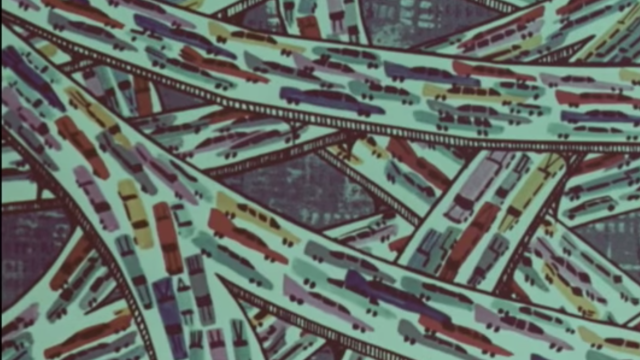Fiat went through the wringer in the 1970s. The original 500 was canned and the the brand introduced a new wave of front-wheel drive hatches. Eventuallyr the Ritmo was launched, but not before a major injection of cash from a man in North Africa named Muammar Qaddafi. The first Fiat plant was opened in the major overseas market of Brazil. The company had to change because it was up against a lot back then. And while most of the marque’s more creative decisions of the era at least appeared to attempt to drive sales (Fiat X1/9, I see you), this film stands apart.
Because when Fiat of 1977, in the midst of all those growing pains, decided to put out a short animated film, it didn’t make up your average short advertising film. No, this was nothing like BMW’s The Hire. It’s hardly an ad at all, to be honest. Why? Because the film itself is honest. It holds back almost nothing about the challenges car culture posed to humanity and vice versa back in 1977. I guess that’s what an angsty Fiat, torn up by a market in upheaval, might put out. It’s oddly raw, even pessimistic about the product it’s promoting, but that’s exactly what I like about it.
The nearly forty-minute film intersperses animated shorts of varying styles with live-action sketches depicting a motorist confronted by the very real human ills created and exacerbated by the automobile. From depicting choking congestion and the dangers of road rage to a somewhat racist attempt to tackle automotive machismo, the animated segments slowly convince the protagonist that his love affair with cars is much more costly than he first realised.
All ll the while the animators challenge the viewer with ever more imaginative depictions of cars, the people who drive them, and the roads they occupy. I wish I could speak a little more to what’s going on with the style of animation (I’ll pretend to go to film school someday) but just take a moment to see a few of the shorts. Each one clearly took an immense effort to animate and the results are just beautiful.
Fiat must have been aware that you might come away from this film a little worried that the automaker had totally lost its drive, that the tragedy of the motorcar had taken in its toll on the big brand from Turin, and that’s why there’s a disclaimer at the beginning:
The car is an integral part of the everyday life of the modern world. It provides material for paintings, songs, novels, posters, sculptures, comic strips, and films.
In ‘CARTOONS’ you’ll be seeing the car as observed by animated cartoonists in moods that vary from from the absurd to the cynical. Some of these cartoons are critical of the car and drivers but we see no reason to conceal such attitudes for after all it is not the car that is good or bad, but the way we use it.
Let’s use it intelligently, then— and enjoy ‘CARTOONS’.
That seems to be a rather enlightened perspective for a piece of film put out by an automaker, but it’s important to remember just what Fiat was contending with during the late ‘70s. 1977, when this film came out, was right in the middle of the Years of Lead, when the Red Brigades had their sights on symbols of Italy’s troubled process of industrialisation, Fiat chief among them. Add to that the backlash from the Right against that 1976 loan from Libya and all it entailed and Fiat was in a tough spot.
Absent a clear explanation form the company itself, it seems reasonable to assume that putting out a project like this might have been seen as an aesthetic olive branch, an attempt to convey a degree of self-awareness on the part of Fiat that might have been seen as lacking by a company still helmed by the glamorous Agnelli clan.
Luckily, Fiat remains self-reflective and Centro Storico Fiat, Fiat’s archive, has brought the film (along with many other visual artifacts from the firm’s past) to Youtube.
It should be noted that in addition to cartoons, the Agnelli family was still making sure that the company was still succeeding in the auto market, at least enough to pay for trips to the French Riviera.
While Fiat seemed to be aware that the effects of the proliferation of the automobile were in full effect, it still had some hope for the car as a force for fun and excitement. It was still making the 124 Spider in 1977 and the recently-introduced Bertone-penned, mid-engined X1/9 was also on offer. You know, in case you weren’t totally sold on the “cars are merely a neutral medium for the automation of human existence” thesis Fiat was clearly onto with these cartoons, for whatever it’s worth.
